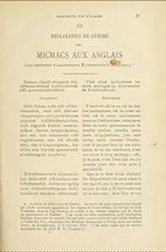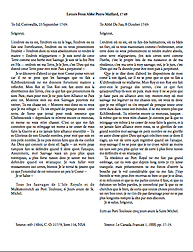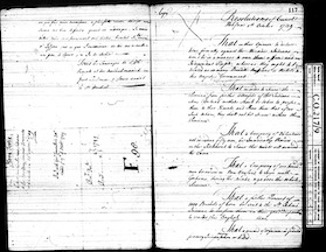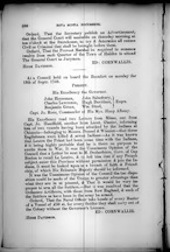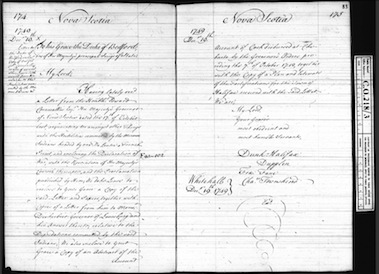Background: In 1734, a priest named Abbe Pierre-Antoine-Simon Maillard (1710-1762) was dispatched to Quebec by the Foreign Missions in Paris. He subsequently began his work at Louisbourg on Cape Breton Island (Ile Royale) in 1735. During the winter of 1737, Maillard managed to master the Mi'kmaq language and perfected a system of hieroglyphics to facilitate transcriptions. He developed formulas for the principal prayers and the responses of the catechism. Similar work had been carried out by Father Chrestien Leclercq at the Gaspe Pininsula in 1691.




Maillard believed his visits to the Mi'kmaq in Cape Breton and Prince Edward Island were too intermittent. He therefore requested a permanent mission at Chapel Island after 1754, just south of his main mission in the south of Bras d'Or Lake. It is here where much of his valuable historical records were written. For a more detailed biography go to the Dictonary of Canadian Biography.
The purpose of my article is to examine, in detail, two letters, most often referred to as the "Declaration de Guerre" or "Declaration of War," written by Father Maillard on behalf of the Mi'kmaq under the leadership of sakmow Thomah Denys. The original was sent to the then governor of Nova Scotia, Edward Cornwallis, in Halifax (23 September 1749), and the other, essentially an aide-memoire, to Abbe Du Fau in Paris (8 October 1749).
I developed this page primarily to present the available evidence and then make a conclusion based on that evidence. I present original documents where possible and not simply make references to them. The page is also a work in progress, therefore, it is a continual state of change. (Click on the thumbnails to see the larger documents.) Please take note that French accents are not present in the body of this html but do appear in the PDFs.
My efforts were also aimed at locating a Mi'kmaq to English translation of Maillard's original letter to Cornwallis. Despite several visits to the Nova Scotia Archives, queries to Cape Breton University, the Nova Scotia Museum, the Treaties & Aboriginal Rights Research organization (TARR), and the Confederacy of Mainland Mi'kmaqs, as well as discussions with other researchers, this translation has remained elusive.
At the conlusion of this article, I offer my own interpretation/translation (French to English) of Maillard's original letter to Cornwallis.
The purpose of my article is to examine, in detail, two letters, most often referred to as the "Declaration de Guerre" or "Declaration of War," written by Father Maillard on behalf of the Mi'kmaq under the leadership of sakmow Thomah Denys. The original was sent to the then governor of Nova Scotia, Edward Cornwallis, in Halifax (23 September 1749), and the other, essentially an aide-memoire, to Abbe Du Fau in Paris (8 October 1749).
I developed this page primarily to present the available evidence and then make a conclusion based on that evidence. I present original documents where possible and not simply make references to them. The page is also a work in progress, therefore, it is a continual state of change. (Click on the thumbnails to see the larger documents.) Please take note that French accents are not present in the body of this html but do appear in the PDFs.
My efforts were also aimed at locating a Mi'kmaq to English translation of Maillard's original letter to Cornwallis. Despite several visits to the Nova Scotia Archives, queries to Cape Breton University, the Nova Scotia Museum, the Treaties & Aboriginal Rights Research organization (TARR), and the Confederacy of Mainland Mi'kmaqs, as well as discussions with other researchers, this translation has remained elusive.
At the conlusion of this article, I offer my own interpretation/translation (French to English) of Maillard's original letter to Cornwallis.
* * *
An esteemed Mi'kmaq historian has stated to me that the letters to Edward Cornwallis and Abbe Du Fau were indeed meant to express a declaration of war. This notion, handed down through the Mi'kmaq Oral Tradition does not seem readily apparent in the available English translations from the 18th Century French (considered "modern"); which are incomplete at best. I mentioned to my colleague that if it were true that the letter was indeed meant to be a declaration of war, then from the documented evidence available, Abbe Pierre Maillard perhaps failed in his attempt to impart this meaning in French. Maillard refused to teach the Mi'kmaq how to read or write French because he believed they would abuse the language by learning what was evil rather than what was good ("Lettre de M. L'Abbe Maillard sur les Missions de l'Acadie et particulierement sur les Missions Micmaques," Les Soirees Canadiennes: Recueil de Litterature Nationale, III (Quebec, 1863), p. 358). The Mi'kmaq would have put their full trust in Maillard to impart their true intentions to Cornwallis.
When I began my initial research for this page, I attempted to find a translation from the Mi'kmaq version contained in the letter to Du Fau with very little success. I understand that the intent of the letter has been passed down through the Oral Tradition. However, I wanted more than just rhetoric and generalities but a substantive translation that spoke to the overall content of the actual letter itself. An accurate translation of this document to English from the Old Mi'kmaq, a polysynthetic language that is composed of many morphemes, may add some further insight.
When I began my initial research for this page, I attempted to find a translation from the Mi'kmaq version contained in the letter to Du Fau with very little success. I understand that the intent of the letter has been passed down through the Oral Tradition. However, I wanted more than just rhetoric and generalities but a substantive translation that spoke to the overall content of the actual letter itself. An accurate translation of this document to English from the Old Mi'kmaq, a polysynthetic language that is composed of many morphemes, may add some further insight.
* * *
The Letters: After establishing an initial settlement in Halifax in the summer of 1749, it was imperative that Governor Edward Cornwallis make peace with the Native peoples of the province before further colonization could proceed. On 15 August, Governor Cornwallis and members of his Council met with representatives of the Penobscott, Naridgwalk, St. John, Cape Sable and other tribes aboard HMS Beaufort in Halifax Harbour. They agreed to sign a redrafted treaty of 1725 that would be ratified at a later date. The dialogue between them and the treaty itself are displayed below (Selections from the Public Documents of the Province of Nova Scotia, Akins, 1869).

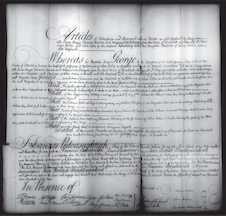


Governor Cornwallis was informed in August that two vessels were attacked by the Indians at Canso whereby "three Englishmen and seven Indians were killed." Council believed the attack had been orchestrated by an Abbe Le Loutre, [the assistant of Abbe Pierre Maillard, a missionary who lived on Chapel Island and was a spiritual leader to the Mi'kmaq.] (Akins, 1869, p. 580) Prior to this incident, the priest had written the following to the minister of marine in France: "As we cannot openly expose the English ventures, I think that we cannot do better than to incite the indians to continue warring on the English; my plan is to persuade the Indians to send word to the English that they will not permit new settlements to be made in Acadia. . . I shall do my best to make it look to the English as if this plan comes from the Indians and that I have no part in it." (The Atlantic Region to Confederation - A History, Eds. Phillip A. Buckner & John G. Reid, 1994 U of T Press Inc., p. 129)
The correspondence (shown below) was written on behalf of Mi'kmaq tribes gathered at Port Toulouse on Cape Breton Island (Isle Royale) by Abbe Pierre Maillard. The letter, dated 23 September 1749, was sent to Governor Edward Cornwallis in Halifax. A copy was included in a 17 October report to Secretary of State Bedford.* This report also included a copy of the scalping proclamation of 1 October 1749.
*From the Canadian Archives, 1894): A letter of the same date (October 17) was written by Cornwallis to Lords of Trade, not identical, although to the same general effect. F. 95, B. T. N. S. vol. 9- The enclosures are the same and marked F. 96 to F. 100, but the plan mentioned in F. 85 (August 20), is additional marked F. 102.
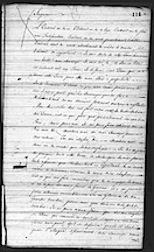
The correspondence (shown below) was written on behalf of Mi'kmaq tribes gathered at Port Toulouse on Cape Breton Island (Isle Royale) by Abbe Pierre Maillard. The letter, dated 23 September 1749, was sent to Governor Edward Cornwallis in Halifax. A copy was included in a 17 October report to Secretary of State Bedford.* This report also included a copy of the scalping proclamation of 1 October 1749.
*From the Canadian Archives, 1894): A letter of the same date (October 17) was written by Cornwallis to Lords of Trade, not identical, although to the same general effect. F. 95, B. T. N. S. vol. 9- The enclosures are the same and marked F. 96 to F. 100, but the plan mentioned in F. 85 (August 20), is additional marked F. 102.

Please note: No serious work has been carried out on these translations for nearly two decades. The reasons why several lines were omitted from these published translations is unknown. The overall texts seem quite literal as they do not flow and, in particular instances, do not make sense. I have written to Stephen Patterson requesting his complete translation but have not received a reply. Leslie F. S. Upton passed away in 1980.
The English translations of the 23 September and 8 October letters presented on this page appear to be from the 18C French and not the Old Mi'kmaq, e.g. use of the phrase "as it were." It is also important to remember that no document with the Mi'kmaq text contained in the original letter to Cornwallis has ever surfaced to my knowledge, and remains the unknown factor. It follows that this particular Mi'kmaq text would differ from that of the Du Fau letter because the record documents clearly show the French word forms Maillard used in the respective letters to be very dissimilar.
The following nearly complete English translation of Maillard's letter to Cornwallis was provided by Stephen Patterson (UNB) for Mi'kmaq Treaties on Trial, History, Land, and Donald Marshall Junior by William C. Wicken (2002, University of Toronto Press) pp. 179-180.
The English translations of the 23 September and 8 October letters presented on this page appear to be from the 18C French and not the Old Mi'kmaq, e.g. use of the phrase "as it were." It is also important to remember that no document with the Mi'kmaq text contained in the original letter to Cornwallis has ever surfaced to my knowledge, and remains the unknown factor. It follows that this particular Mi'kmaq text would differ from that of the Du Fau letter because the record documents clearly show the French word forms Maillard used in the respective letters to be very dissimilar.
The following nearly complete English translation of Maillard's letter to Cornwallis was provided by Stephen Patterson (UNB) for Mi'kmaq Treaties on Trial, History, Land, and Donald Marshall Junior by William C. Wicken (2002, University of Toronto Press) pp. 179-180.
